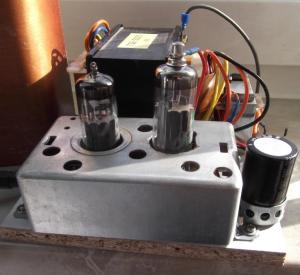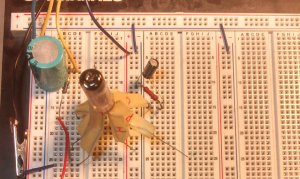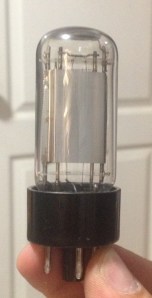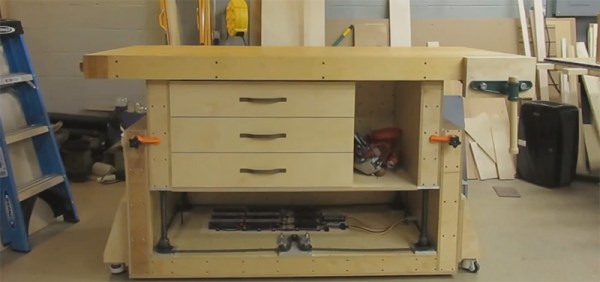This is a post about workbenches, but not the benches you’re probably thinking about. Workbenches meant for electronics development are simple matters – just about any flat surface, a few shelves for equipment, and an anti-static mat will be fine for every conceivable use. Workbenches for woodworking are a separate matter entirely. There’s actually quite a bit of history behind the development of the woodworking workbench, but the basic idea is a thick laminated wood top, integrated vices, holes in the work surface for bench dogs, and ergonomics that allow for comfortable use of hand tools. The basic design of these benches hasn’t changed much in several hundred years, and [Dirk] thought the design was ready for a modern update.
Day: November 21, 2014
Upgrading A Laminator For Toner Transfer PCBs
If you need a circuit board now, you’re probably looking at a toner transfer process; all you need to make a PCB is a copper clad board, a laser printer, some special paper, and the usual etching chemicals. The quality of these boards is highly dependant on the quality of transferring toner to the copper, and getting the process right is as much an art as it is a science. A clothes iron is the easy way of transferring the toner to the board, but if you’re looking for repeatability, you’ll probably want a laminator.
Laminators, too, also vary in quality. The king of toner transfer laminators is the Apache AL13P. With four heated rollers and a steel chassis, it’s enough to do some serious heating. [mosaicmerc] came up with an amazing mod for his Apache laminator that takes all the guesswork out of the settings, and does it all in one pass for maximum repeatability and PCB quality.
The Apache laminator in question is a beast of a machine that drives four rollers with a synchronous motor and also has a ‘reverse’ button that sends the laminations out the front end of the printer. Stock, a toner transfer PCB would require dozens of passes through the Apache, but [merc]’s mod takes care of everything for you.
The addition that makes this possible is a small board with a PIC12 microcontroller. This microcontroller connects the motor driver board and the display interface together, triggering the reverse button to move the board 5/8″ forward and 1/2″ back, giving the laminator an effective speed reduction of 12:1. This method also has the bonus of not tampering with the motor or control circuitry, and allows for multiple passes in the same run.
With this modification, the Apache AL13P becomes the perfect solution to transferring toner to a piece of copper, with the ability to transfer 10mil traces on 1oz copper. The board also offers some other features like thermal sensor failure shutdown and a cool-down mode that overrides the heater. If you’re looking for an easy way to step up your toner transfer PCBs, you can’t do much better than this mod.
We’re Hiring
The Hackaday crew has done some amazing things this year, and we’re finding ourselves a bit stretched. Want to lend a hand while making some extra dough to plow back into your projects? This is a work-from-home (or wherever you like) position that affords you the opportunity to guide what we cover on Hackaday.com. We hire writers for their judgement, which helps keep our subject matter fresh. But don’t worry, we do have a very active tips line from which many of our story leads come.
Contributors are hired as private contractors and paid for each post. You should have the technical expertise to understand the projects you write about, and a passion for the wide range of topics we feature. If you’re interested, please email our jobs line and include:
- Details about your background (education, employment, etc.) that make you a valuable addition to the team
- Links to your blog/project posts/etc. which have been published on the Internet
- One example post written in the voice of Hackaday. Include a banner image, 150 words, the link to the project, and any in-links to related and relevant Hackaday features.
Words of encouragement
First off, we won’t be discussing compensation publicly. Want to know what we pay? Send in a successful application and we’ll talk about it.
Secondly, don’t pass up this opportunity. I watched one of these posts go by and waited another year before I saw the next one and applied. Now I’m running the place. Our team is made up of avid readers. If you’re passionate about the stuff you read here and you have a few hours each week to do some writing you need to apply now!
So what are you waiting for? Ladies and Gentlemen, start your applications!
3DS Homebrew Channel And Custom Firmware
Nintendo has always been very wary about allowing independent and homebrew developers making games for their consoles, and the 3DS is no exception. It’s locked down, and a few 3DS and console hackers have spent years searching for a method that will easily allow anyone to run unsigned code. That day is finally here. The exploit is called NINJHAX, and it allows anyone to install the Homebrew Channel, the repository for everything awesome in the world of 3DS homebrew development.
The latest exploit relies on a bit of code in a retail game – Cubic Ninja – to run unsigned code. This game includes a level editor that allows players to share different levels by QR codes and 3DS’ camera. By carefully crafting one of these QR codes, the 3DS gains the ability to run the Homebrew Channel
If this exploit sounds familiar, you’re right. The most common way to open up a Wii for homebrew development is Smash Stack, an exploit found in Super Smash Bros. Brawl. This exploit also works by modifying custom stages, and opened the door to a wealth of homebrew development for the Wii.
In the video below, [smea] shows off his exploit by starting Cubic Ninja, going to the QR code level editor, then loading up homebrew games. A copy of the game that enables this exploit, Cubic Ninja, is required for this exploit. Last week, you could buy Cubic Ninja for a few dollars on eBay and Amazon. Today, the price has settled around $50, with a few very dumb or very eager people paying up to $300. If you already have the game, you’ll only need to get the homebrew starter kit, generate a QR code, and start installing unsigned code. All the instructions are available on [smeal]’s site.
Hacklet 23 – The Groove Tube
The transistor may rule the electronics world today, but before solid state moved in, vacuum state was king. Tubes, or valves if you’re from Europe, were the only way to fly. Every good hacker knew their triodes from their tetrodes and their pentodes. While technology has moved on, some hackers keep the past alive with tube based projects. This week on the Hacklet, we’re featuring some of the best tube projects on Hackaday.io!
 We start with [256byteram] and Tube Television Tennis. [256byteram] is building an entire Pong style game from tubes, including a CRT to display the game. Displaying anything on a standard television means generating lots of timing signals. [256byteram] is doing this by using multivibrators to create one-shots and flip-flop circuits. Tube Television Tennis is still a work in progress, but [256byteram] already can display a paddle and move it around the screen in both X and Y. This project has already blown our minds!
We start with [256byteram] and Tube Television Tennis. [256byteram] is building an entire Pong style game from tubes, including a CRT to display the game. Displaying anything on a standard television means generating lots of timing signals. [256byteram] is doing this by using multivibrators to create one-shots and flip-flop circuits. Tube Television Tennis is still a work in progress, but [256byteram] already can display a paddle and move it around the screen in both X and Y. This project has already blown our minds!
 From [Marcel] comes this great Low Voltage All-Tube Amplifier, which we featured on the blog earlier this year. [Marcel] does tubes without the danger of high voltage by using the ECL82 tube at 40 volts. The ECL82 incorporates both a triode pentode in one package, making it something of an integrated circuit. Power is provided by transformer while a PY88 tube handles rectifier duties, making this truly an all tube amp. A few passive components complete the design. We can’t wait to fire one up and hear some class A goodness while basking in the warm glow only a tube can create.
From [Marcel] comes this great Low Voltage All-Tube Amplifier, which we featured on the blog earlier this year. [Marcel] does tubes without the danger of high voltage by using the ECL82 tube at 40 volts. The ECL82 incorporates both a triode pentode in one package, making it something of an integrated circuit. Power is provided by transformer while a PY88 tube handles rectifier duties, making this truly an all tube amp. A few passive components complete the design. We can’t wait to fire one up and hear some class A goodness while basking in the warm glow only a tube can create.
 No tube article would be complete without some nixies, and [opeRaptor] is here to provide them with Obsolete Time, a nixie tube clock! Obsolete Time uses IN-12 Russian nixie tubes, and goes for a minimalist design. Under the hood it’s all modern tech though, including a Bluetooth radio which allows the clock to be set via an Android app.
No tube article would be complete without some nixies, and [opeRaptor] is here to provide them with Obsolete Time, a nixie tube clock! Obsolete Time uses IN-12 Russian nixie tubes, and goes for a minimalist design. Under the hood it’s all modern tech though, including a Bluetooth radio which allows the clock to be set via an Android app.
 [Brandon Foltz] is also getting into a vacuum state of mind as he takes Adventures in Hybrid Headphone Amps. [Brandon] is mixing the best of the old and new worlds by using a 6247 tube as the input stage to an LM386 single chip amplifier. This hybrid is still a work in progress, as [Brandon] is trying to clean up the sound from his LM386.
[Brandon Foltz] is also getting into a vacuum state of mind as he takes Adventures in Hybrid Headphone Amps. [Brandon] is mixing the best of the old and new worlds by using a 6247 tube as the input stage to an LM386 single chip amplifier. This hybrid is still a work in progress, as [Brandon] is trying to clean up the sound from his LM386.
Hackaday.io update!
 Did you know that we’re constantly upgrading Hackaday.io? We listen to your input on the feedback project, and we’re always adding new features to the site. If you haven’t noticed, you can now send private messages to other users. We’re sure this will help put users in contact with each other, so they can collaborate on even more projects! On the left side of each profile page there is a “Send a private message” button below the hacker’s avatar. You now have better indicators when you have messages or updates too! The private messages and feed icons at the top right of every .io page now have indicators to show how many messages or feed entries you have waiting. These are all based on live data, so they’ll update as you browse the site.
Did you know that we’re constantly upgrading Hackaday.io? We listen to your input on the feedback project, and we’re always adding new features to the site. If you haven’t noticed, you can now send private messages to other users. We’re sure this will help put users in contact with each other, so they can collaborate on even more projects! On the left side of each profile page there is a “Send a private message” button below the hacker’s avatar. You now have better indicators when you have messages or updates too! The private messages and feed icons at the top right of every .io page now have indicators to show how many messages or feed entries you have waiting. These are all based on live data, so they’ll update as you browse the site.
That’s all the time we have for this week’s Hacklet! As always, see you next week. Same hack time, same hack channel, bringing you the best of Hackaday.io!
Artisanal Vacuum Tubes: Hackaday Shows You How

About a decade ago I started a strange little journey in my free time that cut a path across electronics manufacturing from over the last century. One morning I decided to find out how the little glowing glass bottles we sometimes call electron tubes worked. Not knowing any better I simply picked up an old copy of the Thomas Register. For those of you generally under 40 that was our version of Google, and resembled a set of 10 yellow pages.
I started calling companies listed under “Electron Tube Manufacturers” until I got a voice on the other end. Most of the numbers would ring to the familiar “this number is no longer in service” message, but in one lucky case I found I was talking to a Mrs. Roni Elsbury, nee Ulmer of M.U. Inc. Her company is one of the only remaining firms still engaged in the production of traditional style vacuum tubes in the U.S. Ever since then I have enjoyed occasional journeys down to her facility to assist her in maintenance of the equipment, work on tooling, and help to solve little engineering challenges that keep this very artisanal process alive.
It did not take too many of these trips to realize that this could be distilled down to some very basic tools and processes that could be reproduced in your average garage and that positive, albeit rudimentary, results could be had with information widely available on the Internet.
Continue reading “Artisanal Vacuum Tubes: Hackaday Shows You How”
Tweet Messages From Punch Cards
It all started with a conversation about the early days of computing. The next thing he knew, [Tim Jagenberg’s] colleague gave him a stack of punch cards and a challenge. [Tim] attempted to read them with a mechanical contact and failed. Undeterred, he decided to make a punch card-to-keyboard interface using optical parts from disassembled HP print stations. Specifically, he took apart the slotted optical interrupter switches to use their IR-LEDs and photo-transistors. Next, [Tim] drilled holes into two pieces of plastic, gluing the LEDs on one piece of plastic and the photo-transistors on the other. The photo-transistors tell the Teensy 3.1 whenever a hole is detected.
[Tim] developed an interpreter on the Teensy that reads the punch card according to IBM model 029 keypunch codes. The Teensy enumerates as a USB keyboard when connected to a computer. As a punch card is read, the Teensy outputs the decoded characters as key presses. When a punch card has been completely read, an ‘Enter’ key press is transmitted. Tweeting the punch cards is no more complicated than typing the text yourself. Naturally, the first message posted on Twitter from the stack of punch cards was “Hello World!” [Tim’s] binary and source code is available for download on Github.
We’ve enjoyed covering the backstory of the punch card and a previous project reading these cards using a digital camera setup. It’s always interesting to see the clever ways people use current technology and can-do attitude to read data from obsolete systems that would otherwise be lost. We wonder what is on the rest of those punch cards? Let’s hope [Tim] has more punch card tweets soon!

















